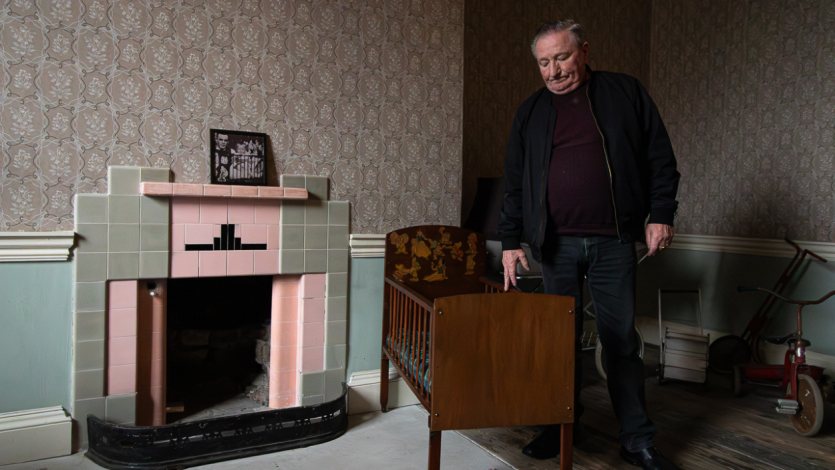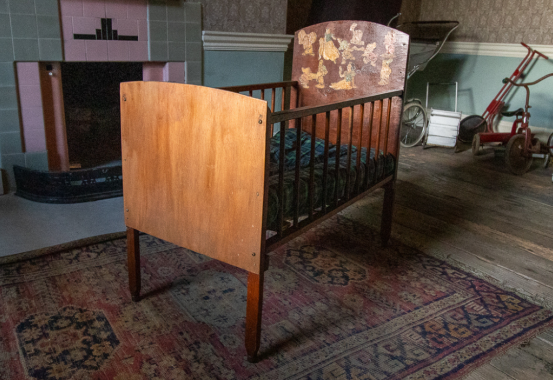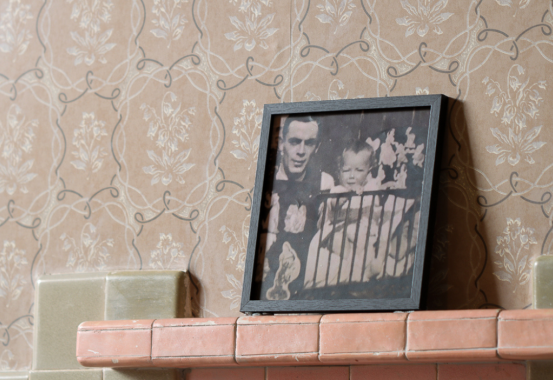Patrick Horrigan’s Cot
NewsStoriesPublished 16 October 2025

This simple wooden cot was made in the 1940s for baby Patrick Horrigan, by his grandfather, William Horrigan. Patrick, now in his early eighties, was born in a back room of 14 Henrietta Street, on 17th April 1943 and lived in a single room of the tenements at 14 Henrietta Street with his family until 1952, when the family moved to a new council house in Finglas. Patrick didn’t move to Finglas with his family, opting instead to move into number 13 Henrietta Street to live in another tenement flat with his great aunt. Patrick grew up at number 13, married and had children there, before moving with his family to the suburbs. Patrick’s grandfather William Horrigan, born in Kilmainham in 1901, was 42 when he made this cot for baby Patrick.
Life in the tenements was hard. The census of 1911 counted over 100 people crammed into the 5 floors of 14 Henrietta Street. Most families lived together in one, or two, rooms of the building, often each original room was subdivided into smaller rooms, these were often sub-let by tenants. The dividing walls were generally only 8-10 feet high, to allow light from the tall Georgian windows into the interior, sub-divided rooms, privacy would have been a rarity.
Tenants often sub-let these smaller rooms, or sometimes even sub-let a bed, or a time-share in a bed. These were the lucky ones. The front door of 14 Henrietta Street would never have been closed. There is evidence that homeless people crept into the house to sleep in the corridors at night. Two stern notices, written in pencil on the walls of the corridor, warn people not to sleep in the corridors - with threats of legal action.
Patrick tells us that the Horrigan family lived all together in the one small room at the back of the house. There were two iron beds squeezed into the room, along with baby Patrick’s cot.
The cot frame is made of wood, with iron supports. The mattress is the original mattress, and is stuffed with horsehair. Patrick tells us that his grandfather William was a labourer, possibly a carpenter. Patrick’s brother, Peter, remembers that food was scarce and that their father, also called William, was often out of work.
The stickers on baby Patrick’s cot are from Disney's very first feature length animated film, 'Snow White and the Seven Dwarfs', released in 1937 and wildly popular. The film had a huge cultural impact on the world, at that time to have 'Snow White and the Seven Dwarfs' stickers on your baby's cot would have been the height of fashion.
The Horrigan’s cot is a rare example in the museum of an object that was made and used in the house by its tenants. A glimpse into one of the many lives that were lived at 14 Henrietta Street during its 300 year history.
14 Henrietta Street is a social history museum of Dublin life, from one building’s Georgian beginnings to its tenement times. We connect the history of urban life over 300 years to the stories of the people who called this place home.
Our guided tours bring to life the stories of the humans who lived in the house, their changing circumstances, their experience of family life, of politics, and the impact of world affairs.
The purchase and conservation of 14 Henrietta Street was the outcome of the Dublin City Heritage Plan 2002-2006, and the Henrietta Street conservation plan. The restoration and conservation of this building was funded by Dublin City Council, with additional support from a Centenaries Capital Grant from the Department of Culture, Heritage and the Gaeltacht.
The building is a major part of our collection, its careful and considered restoration (shortlisted for the prestigious European Union Prize for Contemporary Architecture - Mies van der Rohe Award 2019 and in receipt of a special mention at the prestigious Europa Nostra Awards for Cultural Heritage) suggests much of the building’s history. From the grand Georgian plasterwork throughout the building that sits in contrast to Reckitt’s Blue and Raddle Red paint colours that survive the stairwells, colours that are synonymous with Dublin tenements, the story of the building’s shifting fortunes are etched into its walls.
Alongside this, and equally important to the collection, are the oral histories, physical artefacts, and artistic responses, that all bring the building to life. 14 Henrietta Street is run by Dublin City Council Culture Company and is owned and conserved by Dublin City Council.
 ShopBook Now
ShopBook Now





